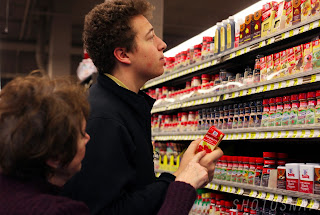Aaron Goh (left) and James Goh (right), the founders of the dotCross Coffee Project, a student-run coffee appreciation project in Hyde Park. They held a coffee tasting session for us and shared a little bit about their project.
They started out the year with 16 pounds of coffee beans, but they are continually acquiring more through friends or on their travels.
Their goal is to create a coffee culture in Hyde Park and get people to appreciate coffee better. In the meantime, they are having a lot of fun learning about coffee. This batch is New Mexico Pinon Coffee, one of James's favorites. (He just thinks it's a cool non-traditional coffee drink)
James and Aaron purchase their beans unroasted (which is actually cheaper) and then roast them themselves.
Home-roasting machine like this one allows even roasting by rotating and stirring the beans while they are heated.
This is a batch of darker roasted beans. Some of the beans are roasted with butter and sugar.(we'd don't add any to our roasts! It's just referring to a traditional Southeast Asian brew (which has butter-sugar roasted coffee)
They write down the process for each cup of coffee they make so that they can learn from each experiment.
This electric kettle allows them to control the water temperature - usually it is set to 198-200 degrees Fahrenheit. Water that is too hot can diminish the flavor of the coffee.
Using a scale allows precision in the number of beans, as changing the number of beans by even just a few can make a huge difference. For this cup they used 22 grams.
Once they measured the right number of beans, Aaron evenly ground the beans using a coffee grinder.
This aeropress fusion brewer puts the ground beans in contact with hot water for a set amount of time.
They extract the flavors out by pressing it through. Preheating the equipment used for brewing reduces the heat loss in the process, making the coffee taste better. This is especially true for French press.
James drinks about 3 cups of homemade coffee a day. When he is not at home, some of his favorite coffee shops on campus are Cobb and the Divinity School cafeteria. Cobb isn't James' favorite cafe - we stand by the Div school, but Cobb is just a place James is often at cause it has food.
The next coffee item on the menu is Guatemala La Cascada from Bridgeport coffee, which had a cherry and grape flavor.
This cup is prepared using a Hario V60 Ceramic Coffee Dripper.
Putting just a little bit of water in at first lets the browns expand, giving the coffee more flavor. Carbon dioxide coming out of the beans creates the foamy structure, called blooming.
This board has served them well on how to get a coffee right. They write down different beans and figure out the best settings for each. The sticky note is here to tell how to get good espresso. Each good shot of espresso makes their day.
Aaron and James bought this espresso machine second hand for about $200. It's tricky to make a good cup of espresso, but worth the effort.
Getting the milk right is an art in itself and is easier to get wrong. Aaron likes to make an analogy to wine to stress the sophisticated nature of coffee.
James and Aaron usually don't like to mix coffee with anything, as they think it cuts out a lot of flavor.
James told us that the usual coffee at any diner has bitter flavor, because it is overextracted, whereas hand brewed coffee gives more control over the coffee you get and guarantees better flavors out of it.
We should appreciate coffee as a beverage in its own right, not as means for caffeine says James as we finish up with our delicious tasting session. To learn more about their project go to: http://dotcross.tumblr.com/




























































